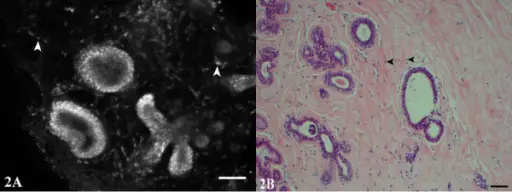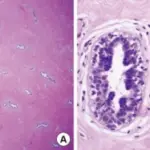Fibrocystic changes are also called diffuse cystic mastopathies. It is a general category for numerous entities, described separately.
What is the Pathology of Fibrocystic Changes?
The pathology of fibrocystic changes is:
-Etiology: The cause of fibrocystic changes is associated with hormonal imbalance or increased estrogen to progesterone ratio, decreased risk with oral contraceptives, perhaps due to balanced supply of estrogens and progesterone.
-Pathogenesis: The sequence of events that lead to fibrocystic changes is determined by estrogen predominance and progesterone deficiency that result in hyperproliferation of connective tissue or fibrosis.
-Morphology: The morphology associated with fibrocystic changes shows clear or blue domed cysts.
-Histology: The histology associated with fibrocystic changes shows the variably-sized cysts scattered in fibrotic breast tissue.
How does Fibrocystic Changes Present?
Patients with fibrocystic changes typically are female. The symptoms, features, and clinical findings associated with fibrocystic changes include that they’re usually bilateral, although one breast may be affected more than the other.
How is Fibrocystic Changes Diagnosed?
Fibrocystic changes are diagnosed through a clinical breast exam. They also can be diagnosed through imaging tests, such as mammography and ultrasound.
How is Fibrocystic Changes Treated?
Fibrocystic changes is treated by estrogen replacement therapy or estrones in adipose tissue.
What is the Prognosis of Fibrocystic Changes?
The prognosis of fibrocystic changes is fair.



